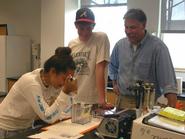
Bryden Considine and Kateri Whitebean, both '08, are no strangers to summer research. Whitebean (Fabius, N.Y.) is spending her fourth summer doing research at Hamilton. As a participant in the Oneida Indian Nation Program for high school students, she gained experience in several different labs in the summers following her sophomore and junior years. Last summer, both Whitebean and Considine (Cabot, Vt.) participated in the STEP/Dreyfus program for incoming freshmen, where they spent six weeks working with Associate Professor of Biology Herman Lehman in a neuroscience lab. "The experience I gained then only furthered my interests in doing research again," said Whitebean.
Whitebean and Considine chose to continue their research with Professor Lehman this summer. They spent 10 weeks on campus working on a project on the analysis of honeybee behavior maturation. Honeybees hatch from larvae as nurse bees that tend to the hive. Later, some older bees develop from nurses into foragers that exit the hive, collect nectar and pollen, and return to feed the other bees. Whitebean and Considine's research focused on the nervous system control of this behavioral transition. Knowing that the level of the neurotransmitter octopamine in the brain plays a vital role in the maturation from a nurse to a forager, they tested a hypothesis that tyramine beta hydroxylase (TBH), the enzyme that speeds up the formation of octopamine, is responsible for the varying octopamine levels in nurse bees and those that transition into foragers. Whitebean and Considine stained honeybee brains to look for clusters of TBH.
"With the comparison of TBH between nurses and foragers, we found that foragers generally had higher levels of TBH. We need to run this a few more times, possibly in the fall, for conclusive evidence," explained Considine. "At the end of 10 weeks we had some results but nothing really outstanding," said Whitebean, "I would love to continue the research and try to get more results. There are so many more avenues we could go with the project that would be interesting and worthwhile."
Considine, a future biochemistry major, also pitches for the Hamilton baseball team in the spring and plays Ultimate Frisbee in the fall. Whitebean, a possible neuroscience major and education studies minor, plays women's basketball and intramural soccer, and is a volunteer for Trust Treat and United Cerebral Palsy.
Both Considine and Whitebean hope to continue doing research while at Hamilton. "The work environment was fantastic and I had a great time in the lab everyday," said Whitebean.
-- by Laura Trubiano '07
Posted August 17, 2005
